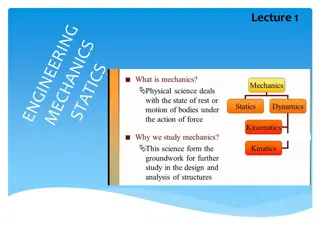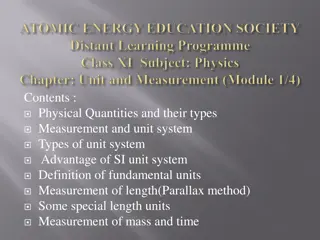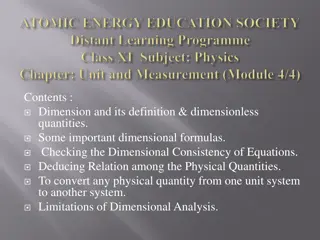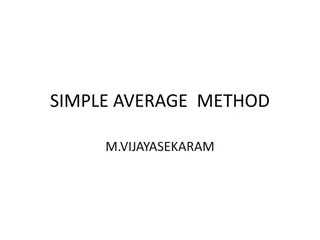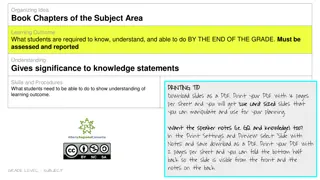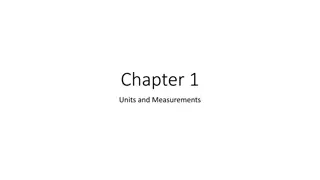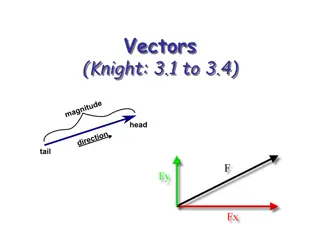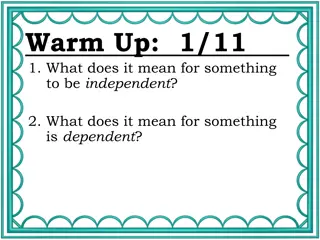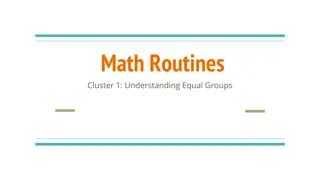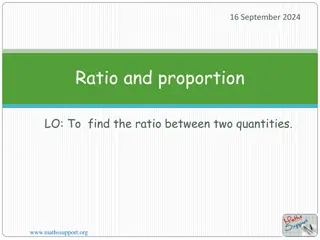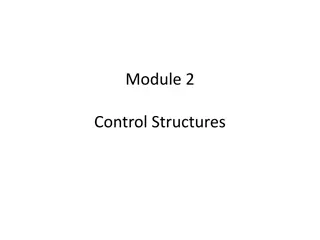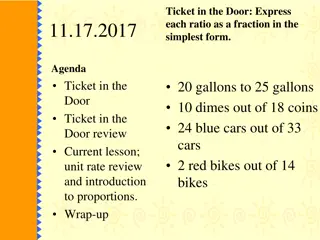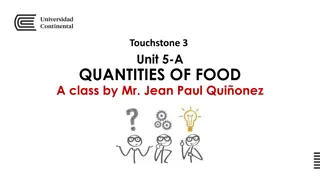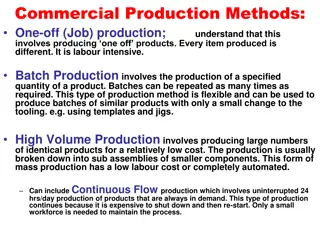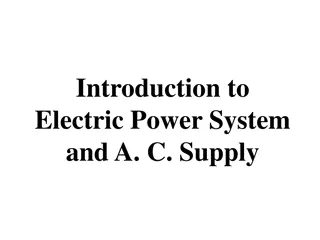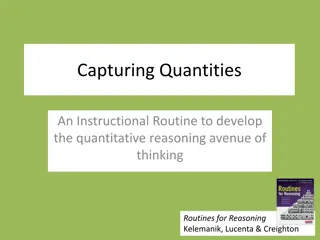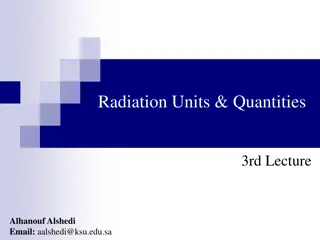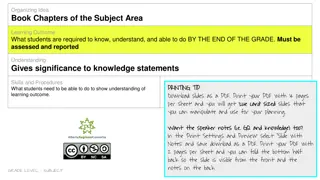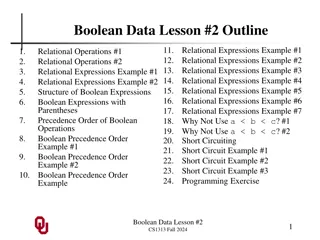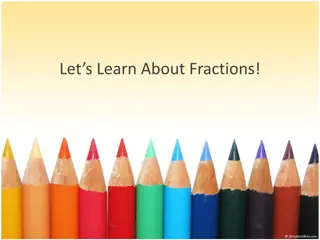Understanding Chemical Quantities: The Mole and Molar Mass
Explore the concept of chemical quantities through the mole and molar mass. Learn how to measure substances, calculate moles, find molar masses of compounds, and solve related problems in this informative chapter. Discover the significance of Avogadro's number, representative particles, and more in
7 views • 41 slides
Angular Mechanics - Angular Momentum Concepts and Examples
Understanding angular momentum in mechanics involves reviewing linear and angular quantities, comparing angular to linear formulas, and exploring examples of angular momentum and conservation principles. The content covers key factors like angular quantities, torque, and moment of inertia, along wit
3 views • 23 slides
Fundamentals of Mechanics: Introduction to Basic Quantities and Units
Explore the foundational concepts of mechanics in this introductory lecture, covering basic quantities like length, time, mass, and force. Learn about idealizations, units of measurement, SI units, conversion of units, and prefixes used in the context of mechanics.
3 views • 7 slides
Exploring Diversity and Equality Through Poetry and Activities
Delve into the themes of diversity, equality, and community through a series of lessons inspired by the poem "People Equal People Equal" by James Berry. This resource provides a range of activities, including reading, performing, and creating class poems, to promote understanding and appreciation of
1 views • 5 slides
Understanding Electrical Quantities and Circuits in Physics
Explore the concepts of electrical quantities such as e.m.f., potential difference, resistance, current, and voltage in circuits. Learn about using voltmeters, measuring resistance, transferring energy in circuits, and understanding the relationships between these electrical properties. Delve into e
2 views • 65 slides
Understanding Physical Quantities and Measurement Systems
Physical quantities can be fundamental or derived, and they play a crucial role in describing physical phenomena. Measurement involves comparing quantities with standard units, with fundamental units for base quantities like length, time, and mass. Different unit systems exist, including CGS, FPS, M
3 views • 13 slides
Understanding Dimensional Analysis in Physics
Dimensional analysis in physics involves defining dimensions of physical quantities, determining dimensionless quantities, checking dimensional consistency of equations, converting units, and exploring the limitations and applications of dimensional analysis. By understanding dimensions and dimensio
0 views • 14 slides
Simple Average Method in Cost Accounting
Simple Average Method, introduced by M. Vijayasekaram, is a technique used for inventory valuation and delivery cost calculation. It involves calculating the average unit cost by multiplying the total unit costs with the number of receiving instances. This method simplifies calculations and reduces
2 views • 5 slides
Understanding Fundamental Right to Equality in Indian Constitution
The concept of equality before the law and equal protection of laws as enshrined in Articles 14 to 18 of the Indian Constitution are essential for ensuring equal status and opportunities for all citizens. Article 14 ensures equality before the law, prohibiting the state from denying any person equal
1 views • 10 slides
Understanding Quantity Analysis in Grade Two Mathematics
Students in grade two are expected to analyze quantities up to 1000 by understanding natural numbers, place values, even/odd numbers, composition of groups, and estimation techniques. The curriculum emphasizes representing quantities, decomposing numbers, skip counting, modeling even and odd quantit
0 views • 19 slides
Challenges and Solutions in Cost Control and Monitoring for Construction Projects in Ethiopia
Construction projects in Ethiopia often face cost overruns due to variations, delays, underestimations, and incomplete designs. The methodology for cost control under General conditions of contract includes clauses related to Bill of Quantities, changes in quantities, variations, and payment procedu
0 views • 10 slides
Understanding Ratios with Practical Examples
Ratios describe the relationship between quantities and can be visualized as parts of a whole. Explore equivalent ratios, sharing quantities based on ratios, and solving scenarios involving ratios with examples. Learn how to find missing values in ratios and apply ratio concepts in real-life situati
0 views • 27 slides
IWG Measurement Uncertainties: Justification of Impact Quantities
Explore the justification of main impact quantities in IWG Measurement Uncertainties session held on 6th and 7th October 2020. The analysis includes factors such as deviation from centered driving, start of acceleration, speed variations, load variations, background noise, temperature effects on noi
3 views • 25 slides
Understanding Proportional Relationships in Everyday Scenarios
Exploring proportional relationships through real-life examples such as pricing at a frozen yogurt store, recipe quantities, and earnings calculation to demonstrate the concept and application in various situations. Proportional relationships ensure that quantities change in a consistent ratio, lead
0 views • 5 slides
Understanding Non-Firm Quantities in Electricity Markets
Non-Firm Quantities in electricity markets involve units with non-firm access not being compensated for their non-firm capacity not getting accommodated on the system. The concept of Firm Access Quantity plays a key role in determining compensation levels for units, with differences in implementatio
0 views • 6 slides
Understanding Units and Measurements in Physics
Physics is the study of nature and its phenomena, involving various physical quantities like mass, length, time, area, and volume. These quantities can be fundamental or derived, with units selected as standards for measurement. The System International (SI) units offer advantages like coherence, ra
0 views • 14 slides
Exploring Vectors: Magnitude, Direction, and Operations
Delve into the world of vectors, understanding their properties, how to add and subtract them, and determining their components in different coordinate systems. Learn about scalar quantities, vector quantities, the tip-to-tail rule, and the role of unit vectors in calculations.
0 views • 19 slides
Equal Exchange Fundraiser - Make Money While Making a Difference!
Discover the benefits of an Equal Exchange fundraiser, offering quick delivery, 40% profit, and high-quality, organic products like rich chocolate bars and flavorful coffees. Choose from a range of delicious options including cocoa, tea, olive oil, and more, all sourced sustainably. Hear testimonial
1 views • 9 slides
Understanding Independent and Dependent Quantities in Graphical Representation
Explore the concepts of independent and dependent quantities through examples such as an endangered species project and a commuter flight scenario. Learn how to identify and represent these quantities graphically to deepen understanding. Engage in activities like jigsaw puzzles and matching graphs t
0 views • 11 slides
Promoting Accessibility Through Captioning: A Guide for Equal Opportunity
Virginia Tech is committed to equal opportunity for individuals with disabilities, promoting accessibility through the C.A.L.M. campaign. The campaign emphasizes compliance with disability laws and guidelines, ensuring equal access to electronic and information technology. Captions play a vital role
0 views • 4 slides
Math Routines and Understanding Equal Groups for Grade 3
Explore math routines for understanding equal groups in grade 3, covering concepts such as interpreting factors as equal groups, multiplication, division, strategies like arrays and repeated addition, and solving word problems involving both operations. Engage in interactive counting activities and
0 views • 16 slides
Fundamentals of Physical Measurements
Science and engineering rely on measurements to understand natural phenomena. Physics aims to predict future outcomes based on observed data and fundamental laws. Base physical quantities like length, time, and mass have standard units, forming the foundation for deriving other physical quantities.
0 views • 13 slides
Understanding Ratios and Proportions in Mathematics
Ratios are a fundamental concept in mathematics that compare the sizes of different quantities. This content explains how to find ratios between quantities, simplify ratios, and work with ratios expressed in different units or containing decimals. Understanding ratios and proportions is crucial for
0 views • 25 slides
Understanding Perl Control Structures and Comparison Operators
In Perl, comparison operators are used for standard comparisons, where Perl supports operators like greater than (>), less than (<), greater than or equal to (>=), less than or equal to (<=), equal to (==), and not equal to (!=). Boolean values like true and false are represented by numerical values
0 views • 25 slides
Understanding Ratios, Rates, and Proportions
Explore the concepts of ratios, rates, and proportions through simple examples and explanations. Learn how to express ratios as fractions in their simplest form and understand the relationship between different quantities. Discover how to compare quantities with the same units and represent ratios u
0 views • 24 slides
Understanding Transportation and Assignment Problem
Transportation and assignment problems involve optimizing the shipment of goods from various sources to multiple destinations while minimizing total transportation costs. These problems deal with limited supply, known demand, constant shipping costs, and integer quantities. The transportation algori
0 views • 64 slides
Combating Ageism in Insurance: Equality Law Perspectives
Combating ageism attitudes in health and age-related insurance through equality law perspectives is crucial in ensuring fair treatment for all individuals. Directives such as Council Directive 2004/113/EC and Equal Status Act 2000 aim to prevent discrimination based on various factors including age,
0 views • 21 slides
Understanding Quantities of Food: Countable vs. Uncountable Nouns
Exploring countable and uncountable nouns in relation to food quantities. Learn how to differentiate them, use adverbs for specific quantities, and understand the nuances of some, any, few, and fewer in food-related contexts.
0 views • 11 slides
Understanding Equality in Politics and Society
Equality is a complex concept encompassing equal rights, treatment, opportunities, and distribution of wealth. Legal equality ensures equal protection under the law, while social equality aims for equal rights and opportunities without discrimination. Liberty and equality are often seen as opposing
0 views • 5 slides
Manufacturing Production Methods Overview
One-off production involves creating unique items with high labor intensity. Batch production allows for the production of specific quantities of similar products using techniques like templates, jigs, and formers. High-volume production focuses on producing large quantities of identical products co
0 views • 5 slides
Understanding Electric Power Systems and A.C. Supply
Exploring the basics of electric power systems, including A.C. and D.C. supplies, circuit parameters, differences between A.C. and D.C. quantities, and the subdivisions of electrical power supply systems such as generation, transmission, and distribution systems. Learn about generating systems, both
0 views • 29 slides
The Inking: A Tale of Squid Society Struggling for Equal Rights
In a city of harmony, squids with either eight tentacles or nine legs find themselves at odds, leading to a conflict over equal rights. The story unfolds as the nines demand changes and the eights resist, resulting in a system of separate but equal treatment. Tensions rise as they struggle to reach
0 views • 11 slides
Developing Quantitative Reasoning with "Capturing Quantities" Instructional Routine
Enhance quantitative reasoning skills with the "Capturing Quantities" instructional routine, which focuses on identifying quantities and relationships, creating diagrams, solving word problems, and reflecting on learning through engaging activities and discussions.
0 views • 9 slides
Understanding Radiation Units and Dosimetric Quantities in Radiology
The field of diagnostic radiology relies on various dosimetric quantities and units to measure radiation exposure accurately. From the use of skin erythema dose to principles of ionization chambers, this lecture delves into the importance of understanding and calculating these quantities for effecti
0 views • 25 slides
Grade One Math Learning Outcomes: Quantity Interpretation and Manipulation
Grade One Math curriculum focuses on developing students' ability to interpret and explain quantities up to 100. Students learn to represent quantities using words, numerals, objects, and pictures. They also understand counting principles, such as hierarchical inclusion, and learn to count forwards
0 views • 17 slides
Subitizing to Enhance Number Sense in Elementary Math Education
Explore the importance of subitizing for developing number sense in elementary students. Discover strategies to help students organize quantities efficiently by tens, recognize place value, and engage in skip counting. Use visual aids like ten frames to support conceptual understanding and reinforce
0 views • 54 slides
Algebra Application in Pharmacy: Solving Two-Step Equations
Pharmacists indeed use algebra in their profession, involving basic algebra, fractions, percentages, and ratios to ensure accurate dosage calculations for medications. Solving for unknown variables in two-step equations is beneficial for pharmacists, as demonstrated in real-life scenarios like deter
0 views • 39 slides
Understanding Relational Operations for Boolean Expressions
Learn about relational operations in Boolean expressions through examples and explanations. Discover how to compare numeric operands to produce Boolean results, covering equal to, not equal to, less than, less than or equal to, greater than, and greater than or equal to operations. The content inclu
0 views • 25 slides
Exploring Fractions: Dividing Shapes into Equal Parts
In this educational lesson, we delve into the concept of fractions by learning how to divide various shapes into equal parts. From pizzas cut into halves, thirds, and fourths to identifying shapes like circles and diamonds divided into equal sections, this exploration provides a fun and visual way t
0 views • 12 slides
Germany's Strategy in Reducing the Gender Pay Gap
Germany faces a 21% gender pay gap due to key factors like women's absence in certain roles, differences in parental leave uptake, undervaluation of women's work, and lingering gender stereotypes. The approach involves enforcing wage transparency, equal pay auditing, and reporting on equal opportuni
0 views • 12 slides


